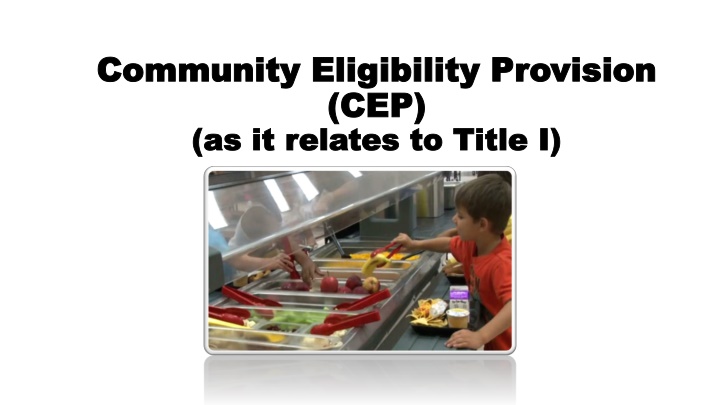
Community Eligibility Provision (CEP) and Its Impact on Federal Programs
Learn about Community Eligibility Provision (CEP), an alternative to household applications for free and reduced-price meals, its eligibility criteria, implications on federal programs, and important related terms. Explore the intersection between CEP and Title I in educational settings.
Download Presentation

Please find below an Image/Link to download the presentation.
The content on the website is provided AS IS for your information and personal use only. It may not be sold, licensed, or shared on other websites without obtaining consent from the author. If you encounter any issues during the download, it is possible that the publisher has removed the file from their server.
You are allowed to download the files provided on this website for personal or commercial use, subject to the condition that they are used lawfully. All files are the property of their respective owners.
The content on the website is provided AS IS for your information and personal use only. It may not be sold, licensed, or shared on other websites without obtaining consent from the author.
E N D
Presentation Transcript
Community Eligibility Provision Community Eligibility Provision (CEP) (CEP) (as it relates to Title I) (as it relates to Title I)
What is CEP? What is CEP? Section 104a of the Healthy, Hunger- Free Kids Act Provides an alternative to household applications for free and reduced price meals Offers all students meals at no cost in high poverty local educational agencies (LEAs) and schools.
What is the eligibility threshold What is the eligibility threshold for participation in CEP? for participation in CEP? Percentage of identified students must be at least 40% of enrollment Eligibility is determined for an entire LEA, a group of schools within an LEA, or a single school within an LEA 3/21/2025 3
What Do You Need to Know in Federal What Do You Need to Know in Federal Programs? Programs? If you choose to participate in CEP All schools participating in CEP must serve breakfast and lunch to all students at no charge All schools participating in CEP will not collect USDA Income Applications Any financial loss must be reimbursed using non-federal funds
Important CEP Related Terms Identified Student Count - count of students who are directly certified for free meals (SNAP, TANF, Foster, Pre-K, Homeless, and Migrant) Identified Student Percentage= Identified Student Count Total Enrollment Low Income Count Non CEP schools and 1st year CEP schools, the LIC is equal to the number of Free and Reduced students (data from fall FRPL forms). For prior CEP schools, the LIC is equal to the number of Free students 1.6 multiplier Low Income Percentage- Low Income Count Total Enrollment Multiplier- Number used to calculate the percentage of lunches/breakfasts to be clamed at the Federal free rate. It is estimated that for every 10 children directly certified, up to 6 additional children were eligible for free or reduced price meals based on a school meal application. The current multiplier is 1.6.
Areas of Intersection Between CEP and Title I Areas of Intersection Between CEP and Title I Within-District Allocations Per Pupil Allocation (PPA) funds from Title I could be affected by CEP status Rank Order of Schools could be affected by CEP Status LEA District Allocation Title I allocation to the school district or LEA is not affected because district allocation based on census data (unless the district poverty went down as a whole)
Within-district allocations in Title I for CEP: YEAR ONE Data from previous year s Fall Collection YEAR TWO YEAR FOUR DC #s and 1.6 multiplier will be used to determine the correct count for PPA. The SEI portal will complete this step, and link the information to eGAP. (Repeat year two and three) YEAR THREE (Repeat year two)
eGAP Enhancements for CEP eGAP Enhancements for CEP The box for CEP Schools will already be checked for participating schools The PPA the 1.6 multiplier already included for CEP schools (Year 2) PPA Low Income Count Low Income Count will be uploaded with
Schools with 100% Poverty If the application of the 1.6 multiplier results in more than one school at 100% poverty, then use the direct certification (DC) data to differentiate among the schools. (i.e. schools with a higher DC number would rank higher). The DC numbers are found on the building Eligibility Page under the Low-Income Students Column. If two CEP schools are both 100% and have the same direct certification rate, they must be provided the same per-pupil allocation. As a reminder: Ranking does not apply when there is one school per grade span or straight allocations are being used where all schools receive the same PPA.
Reminders As usual, the allocations to schools are based on the low- income student count per the Attendance / Eligibility Guidance. With CEP schools, the low income count is your DC number. If rankings change, you will need to send an email with the new rank orders based on the DC numbers to Beth Joseph and Leah Johnston (LEA Accounting): bjoseph@alsde.edu ljohnston@alsde.edu
